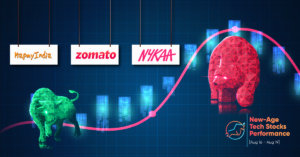We asked IT decision-makers what would drive them to deploy private 5G. In the process, we discovered that many are already exploring this nascent technology.
To take the pulse of technology and business trends, Dell Technologies has been regularly surveying 800 IT decision-makers (ITDMs) across six countries (U.S., U.K., France, Germany, Brazil and China). In our final installment of the series, we cast a spotlight on private 5G. Vincent Ippolito, telco enterprise architect and CTO ambassador, and Zia Syed, CTO 5G, Dell Technologies share their take on the findings.
StartupNation exclusive discounts and savings on Dell products and accessories: Learn more here
We’ve just asked ITDMs how private 5G will revolutionize business in three to five years. What three things struck you?
Vincent Ippolito: Firstly, that 50% of ITDM across six major country markets have rolled out private 5G or are in the process of rolling out private 5G.

This tells me that the 5G revolution is already unfolding. It’s not fully arrived, as we’re approximately 1.5 years into a 10-year journey, but private 5G is now gaining traction (in part because the on-premise infrastructure can be built out today—available spectrum withstanding—whereas the public infrastructure build-out is dependent upon scaling a number of tricky hurdles).
Secondly, this adoption has been influenced by the pandemic: 63% state that COVID-19 and the expedient transition to remote working accelerated their organization’s plans for private 5G.
It makes sense that the two verticals—retail, distribution and transport, plus manufacturing—fast-tracked their private 5G plans the most (73% and 63%, respectively) given the perfect storm of events:
- An exodus of staff (employees on furlough or working from home)
- Skeleton staff on site
- Business ramp up given the sudden shift to online shopping
- Private 5G enabling businesses to take automation to new levels
Whereas 4G connects people to people, 5G connects people to everything. Eighty-four percent of ITDMs forecast that in three to five years, manufactured goods will be flawlessly assembled by artificial intelligence (AI)-powered, data-driven robots that make fewer mistakes.
And thirdly, I’m impressed that the 40% of ITDMs moving forward with private 5G intend to take control of their own infrastructure. In many respects, this makes sense. The research shows that greater security is a foremost driver for investing in 5G (by virtue of having a private network and creating more specialized data movement thanks to network slicing). Fully owning that deployment also enhances their control, and therefore security.
Related: COVID-19 Exposed the Digital Divide: Here’s How We Can Close it with 5G
You mentioned a 10-year window for widespread adoption. However, as you also note, the research shows the COVID-19 pandemic has accelerated R&D in 5G. Can we expect to see the window shorten?
Zia Syed: Building a 5G infrastructure is an immense undertaking. Scaling to hundreds of thousands of cell sites alone takes time—and is a complex undertaking.
There is a way to expedite the process, so it takes under one decade (rather than two), and it involves moving away from the traditional telco model. Instead of trying to do something that’s already very difficult, with even more effort, Dell is actively advocating an alternative approach: one that harnesses the speed of the cloud and IT worlds (using approaches like virtualization and containerization) to do incremental work much faster.
This is possible because 5G is an entirely different beast from its predecessor, 4G. It’s the first software-defined architecture built in the cloud era, meaning it’s highly customizable. So, while we await the largest infrastructure program of our generation, businesses can harness private 5G to orchestrate the network and solve a supply chain issue, for instance.
Over time, the business use cases will proliferate. At present, 22% of manufacturers would use private 5G to track their assets, while 19% in the IT industry are interested in using private 5G to run a real-time digital twin. The stats aren’t overwhelmingly high yet as we’re still at the beginning of the hype cycle. But once businesses can connect all sensors and all things, the only thing limiting factor will be their imagination.
Did the research throw up any surprising vertical findings?
Vincent Ippolito: The financial services industry didn’t accelerate their 5G deployments in the wake of the pandemic to the same degree as the other verticals. But it’s not deaf to the benefits of private 5G. It was the most likely vertical to call out greater security (49%) and higher bandwidth so they can be virtually connected (52%), as two major factors that would drive them to invest in private 5G.
However, being more attuned to these benefits doesn’t necessarily mean the financial services sector has a keener interest in or understanding of what private 5G can do for their business. The pandemic has underscored the importance of secure, remote (connected) work. However, there is a bigger picture. While higher speeds are a clear benefit of 5G, it’s not as life-changing as the tidal wave of efficiency that will be unleashed via 5G’s role in the sensorization of the world. 5G will set off a wonder cycle of use cases by enabling ultra-reliable, low latency communications and massive machine-type communications. Right now, 40% of businesses are motivated to use 5G to connect many more devices and robots. Expect this figure to surge soon.
Sign Up: Receive the StartupNation newsletter!
We’ve ended the “Taking the Pulse” research series with private 5G, on the basis that it’s the connective fabric that enables emerging technologies to positively impact the way we live and work forevermore. Thinking about 5G, which of these forecasts are top of mind again?
Vincent Ippolito: For me, it’s the 87% of respondents that forecast within three to five years, autonomous vehicles will be safe because they’ll constantly be learning the rules of the road and how to respond to unpredictable human behavior. That instantaneous knowledge exchange at the edge requires 5G.
Zia Syed: I would call out the 85% of respondents who predict machines will maintain and service themselves with AI, They’ll even talk to other machines to buy their own spare parts. And the 85% that envisions greenhouses and farms will become fully automated (e.g. carry out routine tasks autonomously like watering plants and harvesting crops, based on data). With private 5G, you can tether a whole sea of sensors that are providing telemetry from an agricultural site. And with network slicing, you can route capacity to where it needs to be.
In time, the level of orchestration and connectivity will herald a new mixed reality experience, where holographic immersive experiences for real-time surgery will be within the realms of possibility.
Originally published on DellTechnologies.com
The post Taking the Pulse: Private 5G appeared first on StartupNation.





![Read more about the article [Funding Galore] $468 Mn Raised By Indian Startups This Week](https://blog.digitalsevaa.com/wp-content/uploads/2022/06/FG_30-May-4-June_Social-300x157.jpg)




